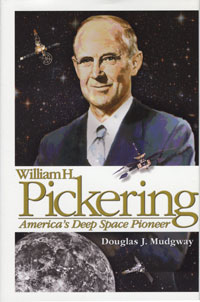Review: America’s Deep Space Pioneerby Jeff Foust
|
| In 1954 he became director of JPL, a posting Pickering considered temporary enough that, rather than give up his Caltech professorship, he requested, and was granted, a leave of absence—one that would last over 20 years. |
Pickering was born in Wellington, New Zealand on Christmas Eve in 1910, but spent much of his formative early years living with his grandparents in the small town of Havelock after his mother died and his father, a pharmacist working for the New Zealand government, was transferred to a post overseas during World War 1. (Pickering attended the same primary school in Havelock that Ernest Rutherford, the Nobel laureate physicist, went to about three decades earlier.) An excellent student, he was encouraged by his great uncle, who had a second home in California, to pursue his education at an up-and-coming university: the California Institute of Technology. Pickering would eventually get his doctorate in physics from Caltech and become a professor of electrical engineering there. During World War 2, he worked part-time at the newly established JPL on electronics and guidance systems for the rockets being developed there. In 1954 he became director of JPL, a posting Pickering considered temporary enough that, rather than give up his Caltech professorship, he requested, and was granted, a leave of absence—one that would last over 20 years.
Pickering did not anticipate a long career at JPL because its work at the time was primarily on missiles for the US Army. However, with the launch of Sputnik in 1957, coupled with the failure of Vanguard two months later, JPL found a new mission in space. The lab built the spacecraft that carried Van Allen’s instrument and was launched by von Braun’s rocket, allowing the three of them to hoist the satellite model over their heads in celebration in the early morning hours of February 1, 1958. The success would soon give JPL—transferred to NASA in late 1958, shortly after the space agency was created—a new mission of developing spacecraft for the exploration of the solar system, and Pickering a new mission of managing a growing lab that had complex relationships with both Caltech and NASA, as well as becoming one of the leading public voices in support of spaceflight.
Pickering remained in charge of JPL throughout the 1960s and early 1970s, running JPL as the lab developed a number of historic missions, like the Ranger and Surveyor lunar probes and the Mariner missions to Venus and Mars. Those efforts did not come without problems, though, particularly the string of failures with the early Ranger missions that exacerbated tensions between Pickering and NASA. Pickering faced a challenge of another kind in the 1970s, as NASA’s budget dropped, leading him to pursue various terrestrial “civil systems” work, with mixed success. Throughout this time, he spoke frequently throughout the US and the world on the importance of space exploration. In early 1976, having reached the retirement age of 65, he stepped down as director of JPL, but rather than resume his professorship at Caltech he pursued a variety of other activities, from helping establish a research institute in Saudi Arabia to founding a company that developed wood pellet fuels. Pickering died of pneumonia in March 2004, a year after making a final trip to New Zealand, where the town of Havelock commemorated a monument to both Pickering and Rutherford.
| Pickering, in retrospect, shared similarities with both Van Allen and von Braun. |
In William H. Pickering: America’s Deep Space Pioneer, Douglas Mudgway provides a relatively straightforward biography of Pickering. Mudgway, a fellow New Zealander who himself worked at JPL for nearly 30 years, is at times a bit hagiographic, putting the best possible gloss on Pickering’s life and work. Mudgway devotes plenty of space to itineraries of Pickering’s speaking engagements and the awards he received, but there’s less detail about the struggles between Pickering and NASA over the management of JPL, particularly during the string of Ranger mission failures that eventually put Pickering’s job on the line. The book leaves unanswered the question of whether the failures were simply inevitable given the technical difficulty of the missions, or if Pickering’s management style, including his frequent travel and reluctance to appoint a deputy director with major powers, played a role.
Pickering, in retrospect, shared similarities with both Van Allen and von Braun. Like Van Allen, Pickering was a trained scientist (both had done cosmic ray research during their careers), although Pickering did virtually no additional scientific work after taking the reins of JPL. Like von Braun, Pickering was a skilled manager as well as a public speaker who helped communicate the importance of spaceflight to the general public. While often lost in the shadow of von Braun and other early space pioneers, it’s clear from this biography that Pickering was a major contributor to the successes in space exploration during the early years of the Space Age, and laid the groundwork for the triumphs that followed to this day.
